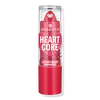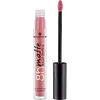What's inside
What's inside
 Key Ingredients
Key Ingredients

 Benefits
Benefits

 Concerns
Concerns

 Ingredients Side-by-side
Ingredients Side-by-side

Bis-Diglyceryl Polyacyladipate-2
EmollientSynthetic Wax
AbrasivePrunus Amygdalus Dulcis Oil
Skin ConditioningPentaerythrityl Tetraisostearate
EmollientPolyisobutene
Ethylhexyl Palmitate
EmollientHydrogenated Castor Oil
EmollientTridecyl Trimellitate
EmollientC12-15 Alkyl Benzoate
AntimicrobialOctyldodecanol
EmollientTrimethyl Pentaphenyl Trisiloxane
EmollientMethyl Hydrogenated Rosinate
PerfumingButyrospermum Parkii Butter
Skin ConditioningSalvia Hispanica Seed Oil
EmollientTocopherol
AntioxidantCamellia Oleifera Seed Oil
Skin ConditioningRosa Canina Fruit Oil
EmollientWater
Skin ConditioningCitric Acid
BufferingPhenoxyethanol
PreservativeParfum
MaskingLimonene
PerfumingCI 15850
Cosmetic ColorantCI 77491
Cosmetic ColorantCI 77492
Cosmetic ColorantCI 77499
Cosmetic ColorantCI 77891
Cosmetic ColorantBis-Diglyceryl Polyacyladipate-2, Synthetic Wax, Prunus Amygdalus Dulcis Oil, Pentaerythrityl Tetraisostearate, Polyisobutene, Ethylhexyl Palmitate, Hydrogenated Castor Oil, Tridecyl Trimellitate, C12-15 Alkyl Benzoate, Octyldodecanol, Trimethyl Pentaphenyl Trisiloxane, Methyl Hydrogenated Rosinate, Butyrospermum Parkii Butter, Salvia Hispanica Seed Oil, Tocopherol, Camellia Oleifera Seed Oil, Rosa Canina Fruit Oil, Water, Citric Acid, Phenoxyethanol, Parfum, Limonene, CI 15850, CI 77491, CI 77492, CI 77499, CI 77891
Isododecane
EmollientTrimethylsiloxysilicate
EmollientOctyldodecanol
EmollientDimethicone
EmollientTribehenin
EmollientPentaerythrityl Tetraisostearate
EmollientSilica
AbrasiveMica
Cosmetic ColorantKaolin
AbrasiveDimethicone/Vinyl Dimethicone Crosspolymer
Skin ConditioningDisteardimonium Hectorite
StabilisingTalc
AbrasiveDiisostearyl Malate
EmollientPolypropylene
Pentaerythrityl Tetra-Di-T-Butyl Hydroxyhydrocinnamate
AntioxidantParfum
MaskingCI 15850
Cosmetic ColorantCI 42090
Cosmetic ColorantCI 45410
Cosmetic ColorantCI 77491
Cosmetic ColorantCI 77492
Cosmetic ColorantCI 77891
Cosmetic ColorantIsododecane, Trimethylsiloxysilicate, Octyldodecanol, Dimethicone, Tribehenin, Pentaerythrityl Tetraisostearate, Silica, Mica, Kaolin, Dimethicone/Vinyl Dimethicone Crosspolymer, Disteardimonium Hectorite, Talc, Diisostearyl Malate, Polypropylene, Pentaerythrityl Tetra-Di-T-Butyl Hydroxyhydrocinnamate, Parfum, CI 15850, CI 42090, CI 45410, CI 77491, CI 77492, CI 77891
 Reviews
Reviews

Ingredients Explained
These ingredients are found in both products.
Ingredients higher up in an ingredient list are typically present in a larger amount.
Ci 15850 is the pigment color red. It is an azo dye and created synthetically.
Azo dyes need to be thoroughly purified before use. This allows them to be more stable and longer-lasting.
This ingredient is common in foundations, lipsticks, and blushes. This color is described as brown/orangey red.
It has many secondary names such as Red 6 and Red 7. According to a manufacturer, Red 6 usually contains aluminum.
Learn more about CI 15850Ci 77491 is also hydrated iron III oxide. It's sole purpose is to give a red/pink hue to products.
Iron III oxides are classified as inorganic chemicals for coloring.
Synthetically created Ci 77491 is considered safer than those naturally found. This is because the synthetically created version may contain less impurities. Iron oxides are generally non-toxic and non-allergenic.
Learn more about CI 77491Ci 77492 is also hydrated iron III oxide. It's sole purpose is to give a yellow hue to products.
Iron III oxides are classified as inorganic chemicals for coloring.
Synthetically created Ci 77492 is considered safer than those naturally found. This is because the synthetically created version may contain less impurities. Iron oxides are generally non-toxic and non-allergenic.
Learn more about CI 77492Ci 77891 is a white pigment from Titanium dioxide. It is naturally found in minerals such as rutile and ilmenite.
It's main function is to add a white color to cosmetics. It can also be mixed with other colors to create different shades.
Ci 77891 is commonly found in sunscreens due to its ability to block UV rays.
Learn more about CI 77891Octyldodecanol is a fatty alcohol. It is primarily used to enhance the texture of products.
As an emulsifier, Octyldodecanol helps prevent the oils and waters from separating. It also prevents ingredients from creating foam when shaken.
Octyldodecanol is created by reducing fatty acid to an alcohol.
Due to its high molecular weight, it does not get absorbed into the skin.
Learn more about OctyldodecanolParfum is a catch-all term for an ingredient or more that is used to give a scent to products.
Also called "fragrance", this ingredient can be a blend of hundreds of chemicals or plant oils. This means every product with "fragrance" or "parfum" in the ingredients list is a different mixture.
For instance, Habanolide is a proprietary trade name for a specific aroma chemical. When used as a fragrance ingredient in cosmetics, most aroma chemicals fall under the broad labeling category of “FRAGRANCE” or “PARFUM” according to EU and US regulations.
The term 'parfum' or 'fragrance' is not regulated in many countries. In many cases, it is up to the brand to define this term.
For instance, many brands choose to label themselves as "fragrance-free" because they are not using synthetic fragrances. However, their products may still contain ingredients such as essential oils that are considered a fragrance by INCI standards.
One example is Calendula flower extract. Calendula is an essential oil that still imparts a scent or 'fragrance'.
Depending on the blend, the ingredients in the mixture can cause allergies and sensitivities on the skin. Some ingredients that are known EU allergens include linalool and citronellol.
Parfum can also be used to mask or cover an unpleasant scent.
The bottom line is: not all fragrances/parfum/ingredients are created equally. If you are worried about fragrances, we recommend taking a closer look at an ingredient. And of course, we always recommend speaking with a professional.
Learn more about ParfumPentaerythrityl Tetraisostearate is derived from isostearic acid. It is an emollient and emulsifier.
The highest concentration of this ingredient is found in lipsticks.
This ingredient is minimally water soluble and may not be Malassezia folliculitis, or fungal-acne safe.
Learn more about Pentaerythrityl Tetraisostearate